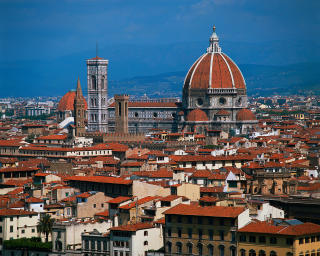 My parents started out the week by joining my class on a field trip to the Museo Nazionale Alinari della Fotografia (the Alinari National Photography Museum), located on the Piazza Santa Maria Novella. My International Business class came here to see a special exhibit of photography by Walker Evans, an American photographer who did his work for the Farm Security Administration during the Great Depression. They had to fill out a worksheet which required them to speculate why the FSA would feel it necessary to hire photographers such as Evans and Dorothea Lange to help it meet its goals of getting money into the hands of poor rural farm families. They also had to choose the one photograph that they best felt illustrated the effects of the Great Depression and explain their reason for that selection. But mostly I wanted them to see this important exhibit. Most of these students are young and have never lived in the United States when it wasn’t prosperous, so the photos were a real eye-opener for many.
My parents started out the week by joining my class on a field trip to the Museo Nazionale Alinari della Fotografia (the Alinari National Photography Museum), located on the Piazza Santa Maria Novella. My International Business class came here to see a special exhibit of photography by Walker Evans, an American photographer who did his work for the Farm Security Administration during the Great Depression. They had to fill out a worksheet which required them to speculate why the FSA would feel it necessary to hire photographers such as Evans and Dorothea Lange to help it meet its goals of getting money into the hands of poor rural farm families. They also had to choose the one photograph that they best felt illustrated the effects of the Great Depression and explain their reason for that selection. But mostly I wanted them to see this important exhibit. Most of these students are young and have never lived in the United States when it wasn’t prosperous, so the photos were a real eye-opener for many. Prior to the field trip, I had also told students that my parents would be coming along. I also explained that my dad was with Kodak for his 30-year career and that they should “pick his brain,” And many of them did just that. Countless times I came upon my dad lecturing away, surrounded by a group of students. He was the real teacher on this day! My mom also thoroughly enjoyed it and was moved by the photographs, many of which were taken the year she was born. She kept returning to the special exhibit room, each time noticing something new.
Prior to the field trip, I had also told students that my parents would be coming along. I also explained that my dad was with Kodak for his 30-year career and that they should “pick his brain,” And many of them did just that. Countless times I came upon my dad lecturing away, surrounded by a group of students. He was the real teacher on this day! My mom also thoroughly enjoyed it and was moved by the photographs, many of which were taken the year she was born. She kept returning to the special exhibit room, each time noticing something new.And did my students get anything out of viewing this historic photograph collection. Here are just a few of the comments they wrote about the photos that they felt best documented the Great Depression:
 Sharecropper, Hale County, Alabama, 1936: “This image grabs you. At the same time I wanted to look away; it’s uncomfortable to see such grim honesty. I stand here in my clean clothes, reflecting on a comfortable life. This man quietly—but intensely—conveys hardship. His expression is serious, his eyes glance off, not absent-mindedly, but as if he is thinking of tomorrow’s day of work in the fields. His clothing is worn and dirty—no doubt his only clothing. The dirt and tears are handprints of his life. Though this man appears to cry inwardly for a break, he asks for no sympathy and seems to accept that he must work this way to survive.” (Rebecca)
Sharecropper, Hale County, Alabama, 1936: “This image grabs you. At the same time I wanted to look away; it’s uncomfortable to see such grim honesty. I stand here in my clean clothes, reflecting on a comfortable life. This man quietly—but intensely—conveys hardship. His expression is serious, his eyes glance off, not absent-mindedly, but as if he is thinking of tomorrow’s day of work in the fields. His clothing is worn and dirty—no doubt his only clothing. The dirt and tears are handprints of his life. Though this man appears to cry inwardly for a break, he asks for no sympathy and seems to accept that he must work this way to survive.” (Rebecca)Sharecropper, Hale County, Alabama, 1936: “It amazes me through one photograph a thousand words can be said. Feelings strongly show through in the sharecropper. He looks so sad that you can hear him speaking even though there are no words. I’m tired, help me. You can tell a story about him simply by looking at him. He has a family, he works hard to make a little to feed them. H loves his children, wants to see them grow up healthy. Longs for a better life for them and works hard to one day see them get there. This to me it the most impactful because you can see his pain and suffering through his unforgiving eyes.” (Meagan M.)
 Child’s Grave, Hale County, Alabama, 1936: “Although maybe not the most powerful right off the bat, this picture was the one that truly stuck with me. The image of a freshly dug grave (that is so small) with a plate on top of it is just wrenching to me. It made me think as well—Could they afford a funeral? Nice clothes for the child who died? A coffin even? This photo to me really expressed just how devastating that kind of poverty can be with a sense of no way out—being able to even feed your child.” (Gianna)
Child’s Grave, Hale County, Alabama, 1936: “Although maybe not the most powerful right off the bat, this picture was the one that truly stuck with me. The image of a freshly dug grave (that is so small) with a plate on top of it is just wrenching to me. It made me think as well—Could they afford a funeral? Nice clothes for the child who died? A coffin even? This photo to me really expressed just how devastating that kind of poverty can be with a sense of no way out—being able to even feed your child.” (Gianna) Untitled (Negro Quarter), Tupelo, Mississippi, 1936: “I chose this photograph as my personal best documentation of the Great Depression because it shows a very old, leaning, broken house with a man peeking inside a window. The yard and background surrounding the house is lifeless and filthy. This photograph portrays, I feel, the lives and attitudes of many during the Great Depression—empty and lifeless with no hope to thrive once again.” (Lindsay K.)
Untitled (Negro Quarter), Tupelo, Mississippi, 1936: “I chose this photograph as my personal best documentation of the Great Depression because it shows a very old, leaning, broken house with a man peeking inside a window. The yard and background surrounding the house is lifeless and filthy. This photograph portrays, I feel, the lives and attitudes of many during the Great Depression—empty and lifeless with no hope to thrive once again.” (Lindsay K.) Cotton Tenant Farmer’s Wife, Hale County, Alabama, 1936: “It shows an entire contrast, she looks as though she is on the verge of breaking down, yet part of her face and eyes stand resolute against the backdrop of the Depression. Symbolic of both the hardship people face and the courage it took to carry on through this Depression.” (Anthony)
Cotton Tenant Farmer’s Wife, Hale County, Alabama, 1936: “It shows an entire contrast, she looks as though she is on the verge of breaking down, yet part of her face and eyes stand resolute against the backdrop of the Depression. Symbolic of both the hardship people face and the courage it took to carry on through this Depression.” (Anthony)Untitled (Landlord), Hale County, Alabama, 1936: “There is one picture that I feel best depicted the Great Depression. The landlord of Hale County was a good representation of the
 Depression for multiple reasons. At first glance, he looks like a well-groomed business man, but once you look closer, you notice that his suit is wrinkled. When you look into his eyes, it’s apparent that he is thinly veiling a look of worry with his proud demeanor. He also is wearing a wedding band. This brings to mind that he has a family to support. All of these things bring out the concern of the people of the Depression. This picture shows a man who once had security and now it’s gone.” (Meaghan G.)
Depression for multiple reasons. At first glance, he looks like a well-groomed business man, but once you look closer, you notice that his suit is wrinkled. When you look into his eyes, it’s apparent that he is thinly veiling a look of worry with his proud demeanor. He also is wearing a wedding band. This brings to mind that he has a family to support. All of these things bring out the concern of the people of the Depression. This picture shows a man who once had security and now it’s gone.” (Meaghan G.) Roadside Stand, near Birmingham, Alabama, 1936: “His photo showcased the fact that some families were completely destitute, but others used the Depression to cut a niche for themselves. To see the prosperous and by what means they prospered shows the needs of the masses more closely. Food brought this family success.” (Lee)
Roadside Stand, near Birmingham, Alabama, 1936: “His photo showcased the fact that some families were completely destitute, but others used the Depression to cut a niche for themselves. To see the prosperous and by what means they prospered shows the needs of the masses more closely. Food brought this family success.” (Lee) Sharecropper Family, Hale County, Alabama, 1936: “The main reason behind my choice is that you can see the whole family in the frame. It shows that it was not just one generation that was touched by the helplessness of their situation. You can feel the sadness radiating from these people. Their loss, their poverty, their exhaustion. To capture all of this in one frame is amazing. Walker Evans let his subjects do the talking; that’s what I love about all of his work.” (Sarah)
Sharecropper Family, Hale County, Alabama, 1936: “The main reason behind my choice is that you can see the whole family in the frame. It shows that it was not just one generation that was touched by the helplessness of their situation. You can feel the sadness radiating from these people. Their loss, their poverty, their exhaustion. To capture all of this in one frame is amazing. Walker Evans let his subjects do the talking; that’s what I love about all of his work.” (Sarah) Yes, they got it. And these images will stay with them a long time, as they stayed with my parent and me throughout the day. That night we had dinner at a small wine bar near the Duomo called Coquinarius. We found ourselves even more grateful for the abundant food and wine served to us that night.
Yes, they got it. And these images will stay with them a long time, as they stayed with my parent and me throughout the day. That night we had dinner at a small wine bar near the Duomo called Coquinarius. We found ourselves even more grateful for the abundant food and wine served to us that night.


No comments:
Post a Comment